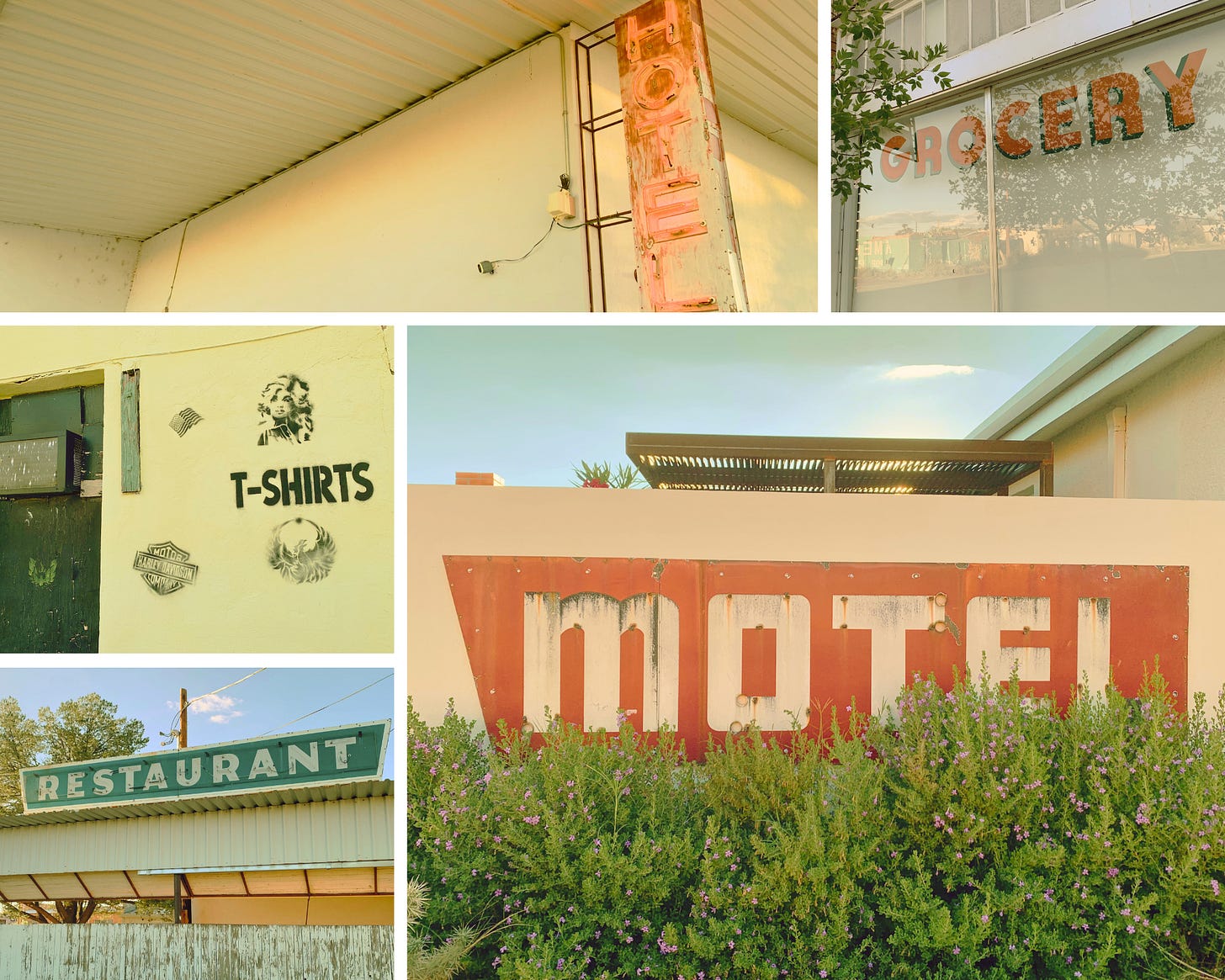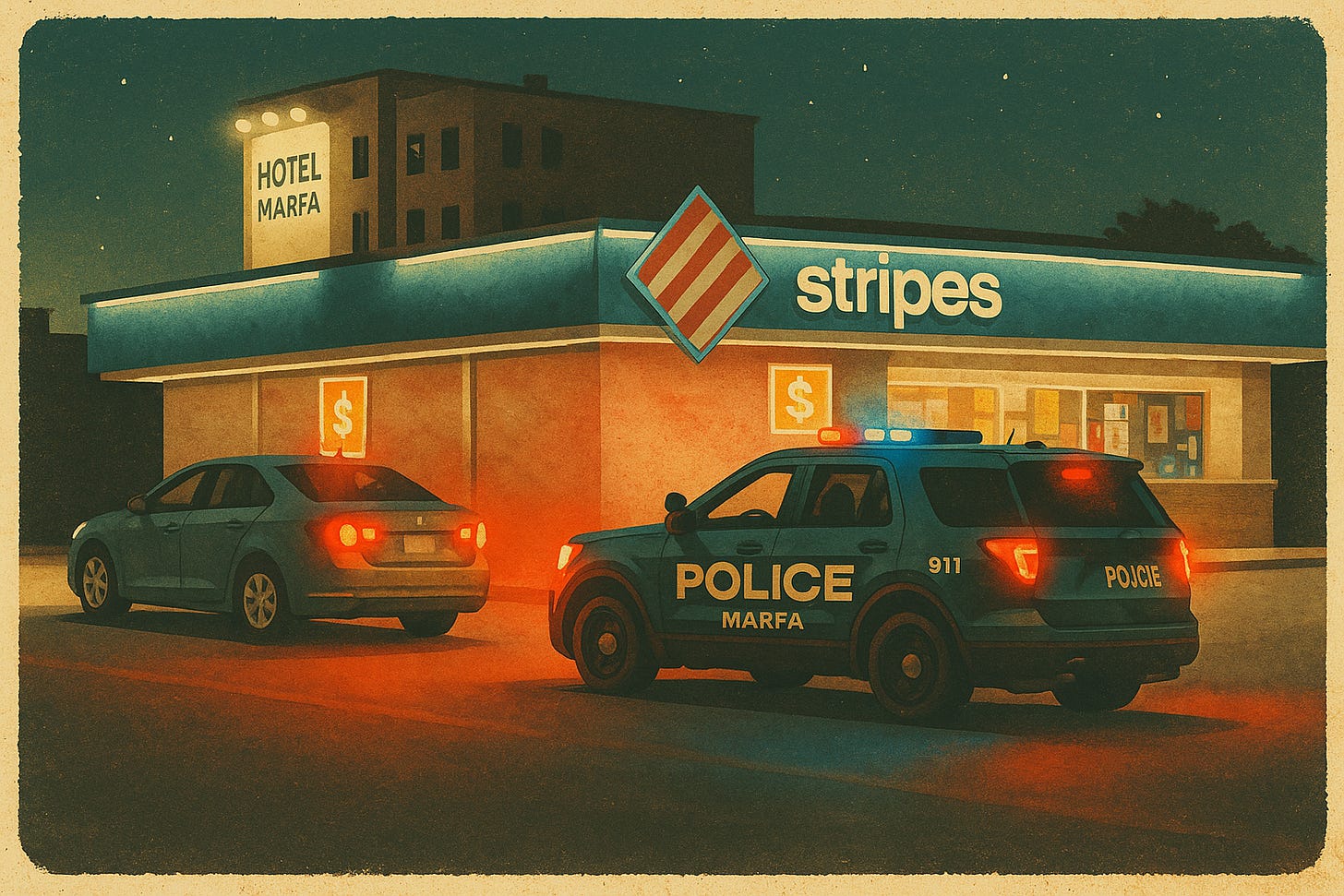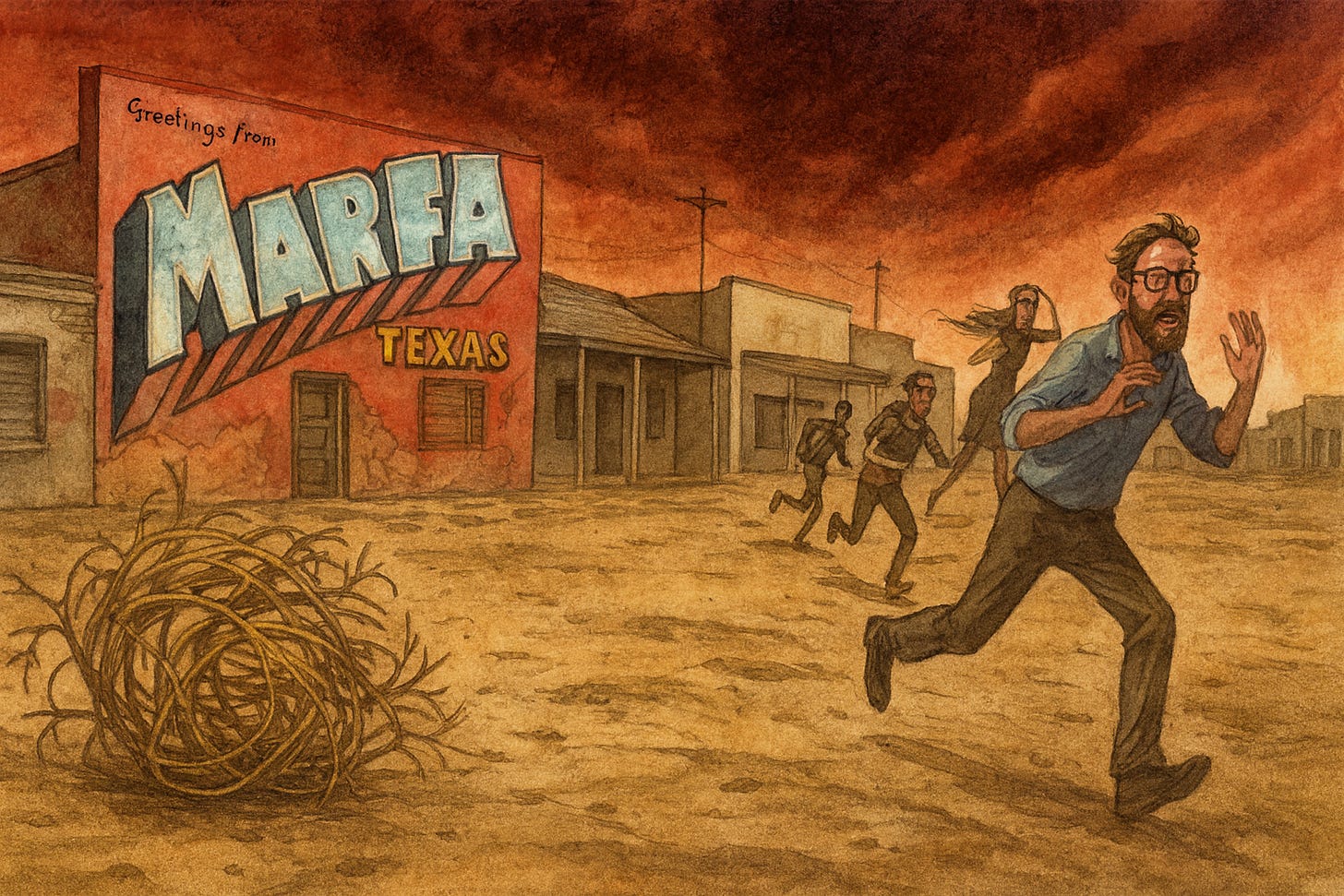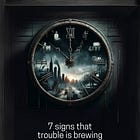The Marfa mirage
A “trust fund science experiment” in the desert looks glamorous on Instagram — but what happens when collapse comes?
Marfa, Texas has always been a little surreal, but after the Collapse Life team spent the summer here watching the rhythms of this town, surreal feels like only half the story.
Once a dusty ranching and railroad town, it was transformed in the 1970s when a minimalist artist named Donald Judd decamped here, turning empty warehouses into art installations and drawing a global creative class to the middle of nowhere. Now, the town is dotted with the kinds of businesses you’d expect to see in a New England college town and not a desert outpost: a pet store, a gourmet grocer, a candy shop, art galleries, a couple of restaurants, and some obligatory souvenir stores. Most of these businesses are open no more than three days a week. One gallery even proudly declares its schedule as: “Hours: Maybe.”
Half the productive-looking buildings in town are empty shells — former auto parts stores, service garages, tire retreading factories, and light industrial buildings now lay dormant or are “performance spaces.” The half that aren’t vacant have largely been turned into Airbnbs or galleries of artwork destined for Instagram clout.
It’s easy to see why someone on Facebook recently described Marfa as a “trust fund science experiment.” The place survives not because it produces anything of value, but because it siphons money from elsewhere.
But don’t take our word for it. The Big Bend Sentinel — a local newspaper once praised by CBS Evening News for its “amazing” resilience in the face of dying print journalism — has, in an ironic twist, been sold to a new buyer who immediately converted it into a “non-profit,” opening the door to funding from foundations and media NGOs. Was the paper ever really for-profit?
That’s the Marfa Shell Game.
Turns out, lots of prosperous city-folk want to play. Wealthy gallerists and second-home owners keep property values high. Tourists roll through for a few days of expensive cocktails, cowboy-hatted selfies, and desert sunsets. Destination weddings and festivals are the economic equivalent of a sugar high — a short-lived income spike that screams ‘unsustainable.’

The businesses here are vanity projects more than livelihoods — no one seems to need them to actually turn a profit. Marfa’s current veneer of prosperity is nothing but a mirage, reflecting excesses in fiat printing and cultural caché more than local reality.
But what happens when the waters of this seemingly abundant oasis evaporate?
In an economic collapse, one of the first things to go is discretionary spending, and with it tourism. When money is tight, nobody drives eight hours into the desert to browse a gallery that is open “maybe.” The boutique shops that were barely viable in good times will likely close overnight. Airbnbs, once the engine of the local housing economy, will sit empty as owners scramble to sell — but who’s buying in a collapse? Even the essential services, thin as they are, will come under strain. The single supermarket or few gas stations that depend on long-haul trucks may not even make it, leaving shelves bare and fuel scarce. In bigger towns there’s redundancy; in Marfa there’s nothing.

And that’s the better scenario. If civil unrest comes, the remoteness that felt like freedom when times were good will become extreme fragility. Police resources, currently focused on people going five miles over the speed limit, will soon become overstretched. Property crime will rise. Empty galleries and second homes will be easy targets. Supply lines will falter, and the ensuing scarcity will breed desperation. The social divide that has always existed — wealthy outsiders with property versus locals trying to eke out a living — could sharpen into genuine resentment.
There really are only two possible arcs from there. Marfa could hollow out, turning into a ghost town of broken neon signs, boarded-up galleries, and sun-bleached billboards for an economy that no longer exists. (See Valentine, TX). Or it could reinvent itself.
Strip away the trust fund experiment and you’re left with acres of open land, spectacular weather, and the bones of a once hard-working ranching town. A few people might turn back to gardening, raising livestock, and trading skills. The raw ingredients of survival are here, if enough people are willing to stay and use them. But what are the chances?
If Marfa could stop being a playground for the urban art world and return to what it was before Prada came to the desert — a hardscrabble, isolated town where survival depends on grit and your neighbors — it could actually have a better chance of surviving the coming hard times. But that train may have already left the station. Feeding yourself on paintbrushes and canvas is a tall order indeed.






It's not a bug, it is a feature.
This happens over and over. Some people do their "build it and they will come" trick on some abandoned dump. They get some people together to market it and then make a profit when people are attracted to the next "New Thing." When that cachet fades, they start a new one somewhere else. Taos, Eagle's Nest, Marfa, and the like. Of course they mainly attract old people who are retired and don't *need* jobs. Then when the investors age out, the places revert to being dumps and ghost towns.
Some of them happen to be a place of enough size that will be self supporting, sort of. They just become tourist traps. Las Vegas, Nashville, Austin, Santa Fe, Venice Beach, New Orleans, Orlando, Key West, Orlando, San Francisco, and the Los Angeles area in general. The only jobs that they have, for the most part, are minimum wage service jobs that don't even earn enough to actually afford to live there.
Many are the brainchild of some ignorant "city development" beaurocrat. One that they did down here where I live was was promoted as the "World Birding Center" which was hyped that it would bring people in droves to birdwatch. Sometimes it takes the form of a professional sports team. Sometimes it is giving financial incentives to companies in the hopes of spurring on development. Usually in the form of massive tax breaks that once run out, the businesses move on to some other desperate community that will underwrite the move.
What a strange little town. I like the way you describe it from a perspective of functionality and sustainability. I find it a little unusual that it exists in isolation there. It brings to mind my recent impression of Niagara Falls ON. that we used to visit as a kid, and later as a mini holiday.
I used to see the glamor and glitz as a nice place to escape to, but now it comes across as a decadent and wasteful money trap. I'm fascinated by the morbid undertones just blocks away from the beautiful falls and parks, where signs of poverty and hopelessness can be found. Like Marfa, it's become an artificial town propped up by tourism and hype disconnected from reality.